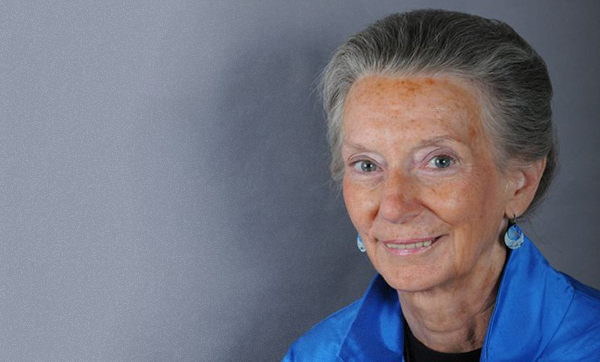Jacqueline Fawcett Leads Nursing Field in Theory, Education, Research.

Jacqueline Fawcett Leads Nursing Field in Theory, Education, and Research
In December 2019, the World Health Organization designated 2020 to be the International Year of the Nurse and the Midwife to honor the 200th anniversary of Florence Nightingale’s birth and to address the sacrifices and inherent challenges of essential healthcare workers in the US and across the globe.
On Tuesday, March 9, the School of Public Health will host the Public Health Conversation “COVID-19 and Frontline Workers: Nurses, Doctors, and Essential Personnel” to discuss the role of frontline workers in a crisis and how public health professionals can best support them. The event is a collaboration among SPH’s idea hub and Office of Lifelong Learning, which includes Population Health Exchange, New England Public Health Training Center, Local Public Health Institute of Massachusetts, and School Health Institute for Education and Leadership Development (SHIELD).
“Although the crucial role that nursologists (AKA nurses) are playing in the care of persons who have contracted COVID-19 is widely recognized, I am concerned that the widespread and positive media and general public attention they’ve received will disappear with the end of the pandemic, with reversion or evolution to the stereotypic view of nursologists as “handmaidens” to physicians,” says Jacqueline Fawcett, a member of the SHIELD Leadership Advisory Board and SPH Dean’s Advisory Board.
A nurse educator and researcher for more than 40 years, Fawcett is internationally recognized for her meta-theoretical work, which focuses on the nature and structure of nursology (AKA nursing) knowledge. A professor in the Department of Nursing in the College of Nursing and Health Sciences at the University of Massachusetts Boston, she has published more than 200 journal articles and book chapters, as well as several textbooks that are staples in nursing curriculums. Fawcett focuses on teaching discipline-specific knowledge—the theoretical concepts that guide nursing practice—to provide students with a framework for understanding and treating the unique health situation of each patient in routine care and major crises.
Fawcett spoke further about the importance of using nursology discipline-specific knowledge, and why nursologists should apply this knowledge in their research and practice as they work to understand and administer optimal care to patients.
You’ve talked about the importance of nursology discipline-specific knowledge, rather than interdisciplinary practice. Can you share more about your thoughts on this?
As nursologists, we must know and use the knowledge developed by other nursologists and ourselves. If we borrow knowledge from other disciplines, we must identify a rationale for doing that and place that knowledge within a nursology context.
I prefer the word multi-disciplinary or the words multiple discipline, rather than interdisciplinary so that everyone is clear that an endeavor is viewed from the distinctive perspective of members of each discipline. Interdisciplinary means that the boundaries of each discipline are blurred, which frequently leads to the perspective of one discipline predominating, especially when members of other disciplines are not able to—or do not want to—articulate the knowledge of their discipline.
You’ve taught and applied the Roy Adaptation Model (RAM) to guide nursing research. Can you explain the value of using conceptual models in nursing education, research, and practice, and how this model fulfills this purpose?
Conceptual models are made up of abstract and general concepts and propositions (statements about the concepts) that address the phenomena of interest to a discipline. In nursology, these phenomena are human beings, environment, health, and nursologists’ activities. The function of a conceptual model is to provide a perspective or guidelines for thinking about and structuring what nursologists do when they conduct research, construct and teach curriculum, and engage in practice.
The Roy Adaptation Model is a widely used nursology conceptual model as a guide for research, curricula, and practice. The focus of the RAM is on how individuals, families and other groups, and communities adapt to environmental stimuli within four modes of adaptation—physiological (body systems), self-concept (feelings about self), role function (roles taken throughout life, such as student, parent, teacher), and interdependence (relationship with family members, friends, and members of the healthcare team).
“I am concerned that nursologists may not be using distinctive nursology knowledge, such as the RAM, as they care for persons with COVID-19, as the overwhelming and exhausting work leaves little time for thinking when there is so much to DO. However, using nursology discipline-specific knowledge during the exceptionally challenging time of this pandemic and at all other times provides a rationale and guide for what we DO. For example, the RAM tells the nursologist to identify the relevant stimuli and observe patients’ responses in the four modes of adaptation. The RAM also tells the nursologist to manage the stimuli to promote positive responses, even if management involves end-of-life care.
As a member of SHIELD and the Dean’s Advisory Board, what are looking forward to regarding the work of BUSPH in the upcoming year?
I am honored to be involved with the BUSPH SHIED initiative and look forward to working with the other members of the SHIELD Leadership Advisory Board to develop educational initiatives that are guided by nursology discipline-specific knowledge targeted to school nursologists.